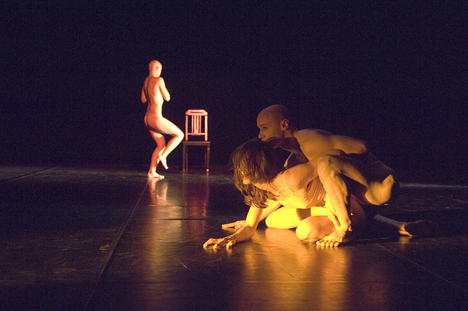Il viaggio – la smorfia della vita: agony and awe

Italian-born and Munich-based, Yvonne Pouget has developed a reputation as one of Europe's leading choreographers. Her skills were very much in evidence on March 5, when she performed Il viaggio – la smorfia della vita (which translates as 'The Journey—The Lottery of Life'), a work built around “la smorfia,” a mysterious divination tool that originates in Naples.
Pouget has trained in Butoh, and I believe this feeds her work in two ways, giving it an intensely inward focus and an eery, almost grotesque edge. The combination is riveting, and more than any other choreographer whose work I have experienced recently, she is able to take the audience into an alternate universe, one where metaphor and passionate emotion reign supreme.
Using a striking collage of physical images and sound, Pouget shows us a human spirit filled with agony and awe. After a video prelude exploring the iconography of la smorfia, the tale was launched. Pouget sat rigidly in a chair, her face framed by a white wimple, so that she resembled a religious figurine. Her arms were concealed behind her, so that she seemed to have only stumps, and her lower body was hidden in shadow. As she moved with aching deliberateness, I kept wondering when these bound arms would finally be free....The strangeness of her posture was accentuated by the contortions of her face, and the piece was paced so slowly that for long minutes all there was to see was the round “O” of her mouth and her horrified eyes.
As the evening advanced, Pouget emerged from this nascent state and passed through a thousand other stages of human growth and decay, sometimes moving rigidly like an ancient crone, sometimes as fluidly as a young woman. Her movements were always taut, and so slow that it truly seems as if she was melting from one shape to another before our eyes. Il viaggio expressed what I think the is real magic of dance, in this capacity for transformation. It is a strange art that takes the same starting point over and over, the basic template of a human body, and defies our expectations by turning it into a fluid, symbol-generating organ. With Il viaggio, Pouget created evocative illusions with her strong physical presence and some strategically cast shadows.
One of my favourite images occured in the latter part of the evening, when Pouget emerged only partially dressed in a black smock. The garment was pulled down to her hips, so that her torso sprouted out of the neckline and the arms hung limply at her hips. Her naked back and shaved head looked exceedingly vulnerable and alien, and seemed to hover over the black stage. Whether she curled herself on the floor or teetered precariously on her feet, she was more than merely human, she was a sculptural manifestation, a human spirit cast in flesh.
Pouget was accompanied in this work by three other performers, an actor and singer, Giacomo Di Benedetto, in the role of “la Feminella” and a female/male pair of dancers. This first figure was an ominous presence throughout the piece. Sometimes acting like a carnival barker, sometimes like an angel of death, and sometimes like a stereotypical Italian patriarch, he slipped in an out of the action, stitching the scenes together. He was a constant reminder that life is never just this moment, it is always also a one-way ticket to the other side. By contrast, the pair of dancers clearly represented the generative aspects of life – their duets were intensely sensual, and -- completely absorbed in the moment -- they were oblivious to Pouget when she passed through their space like a ghost.
This scene, with Pouget and the two dancers, was one of the most memorable for me. The dancers, Katharina Neuweg and Damien Liger (both trained in ballet and modern dance), gave a performance that was passionate and refined. As they lay entwined on the stage, a third body slowly emerged from one of the wings. Until now we had seen Pouget in layers of white lace, and suddenly here was her shorn head and naked form. Her entrance immediately added nuance to what was otherwise a fine but very predictable romantic duet. Her body, female but stripped of feminine accessories, suggested loss – vulnerability, asceticism, even illness – but also strength. If every ridge of her spine was visible, so too was every muscle in her body.
What most impressed me through the evening me was Pouget's fearless way of really using her body, twisting it into tortured shapes and holding it there for longer than I would imagine possible. I was fascinated by this figure, who seemed to operate outside the categories of female and male, young or old.
Il viaggio – la smorfia della vita offers a dark yet very tender look at the human experience, and I was touched by the depth of feeling that it tapped. Yet I was also frustrated by the way that the work opened up so much room for expression but at the same time defaulted to a kind essentialism through the romantic duet. Perhaps it is a risk to expect an audience to automatically engage with "universal" archtypes.
Yet I think the work was very strong for all that it followed a formula, and at its core it pushed beyond the stock characters sketched out on the illustrated chart that was la smorfia. As a figure in the work, Pouget's transformative physicality allowed her transcend arbitrary boundaries, even as she moved to occupy the bounded space within. I most enjoyed her performance (and I'd hazard that she does too) when she was caught somewhere in the limnal spaces between one defined image and the next. Pouget's performance gave viewers the chance to see a body in glorious and bizarre postures that were neither beautiful nor ugly, but both.



